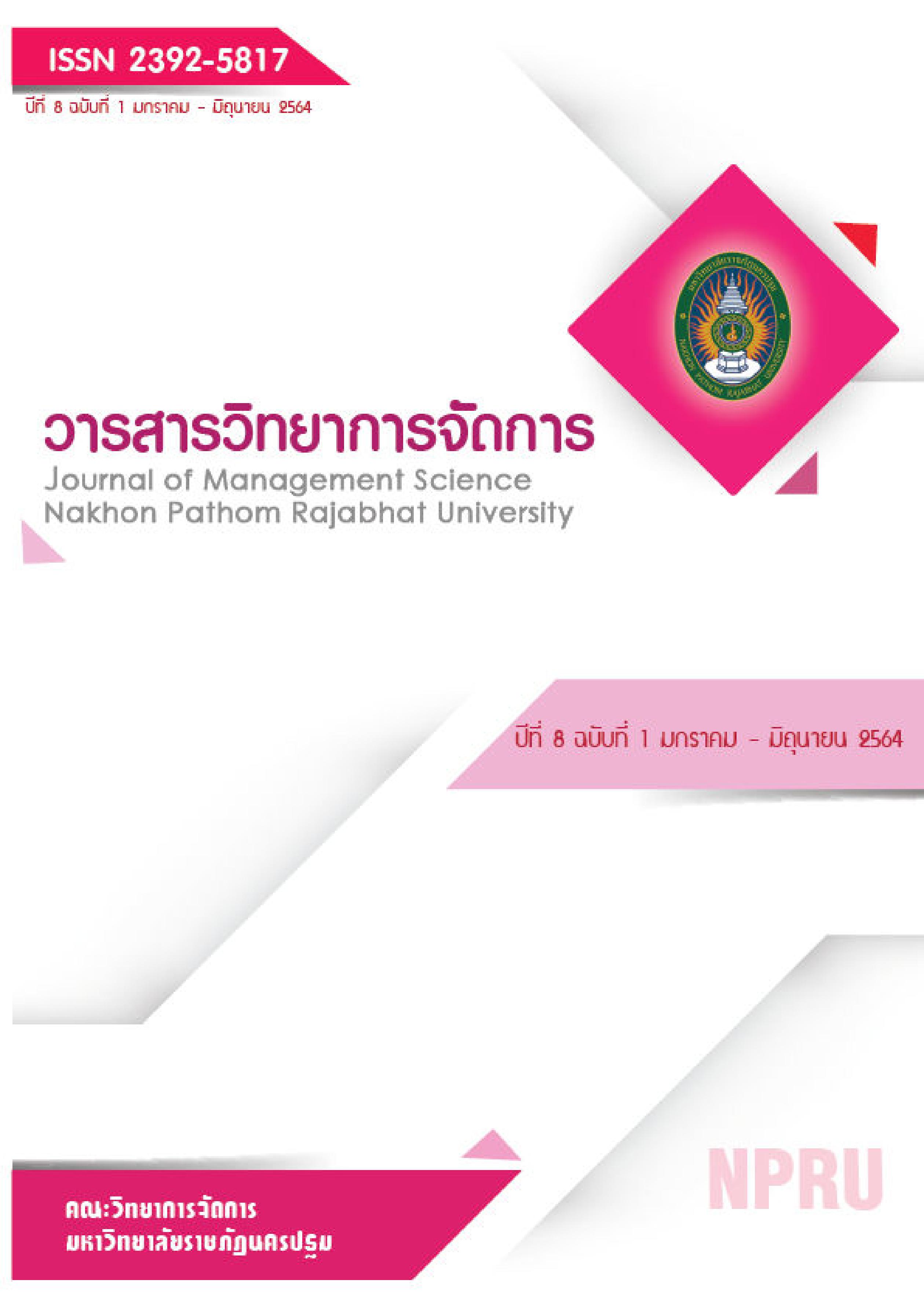Guidelines for developing marketing mix strategies to build brand loyalty among chicken part consumers in western region
Main Article Content
Abstract
This research aimed to study: (1) the brand loyalty of chicken part consumers as classified by personal factors; (2) the marketing mix factors affecting the brand loyalty of chicken part consumers; and (3) the guidelines for developing marketing mix strategies to build brand loyalty among chicken part consumers in western region. Mixed method research was used in this study. The research sample was 400 consumers who bought chicken products in western region, derived by quota sampling. The research instrument was a questionnaire the acceptable content validity and the reliability. The statistics used for data analysis were percentage, mean, standard deviation, t-test, one-way analysis of variance, correlation analysis and multiple regression analysis. Regarding qualitative research, the key informants were 6 managers and consumers derived by purposive sampling. Data were analyzed by content analysis.
The findings of this research were as follows:
1. The brand loyalty of chicken part consumers in western region, when classified by personal factors, was statistically significantly different in the aspects of age, education, status, occupation, and income.
2. The marketing mix strategies to build the brand loyalty of chicken part consumers in western region were marketing promotions (b = 0.23), distribution (b =0.20), product (b = 0.18), and price (b = 0.14). The equation was with the predictive power of 81 percent and could be written as follow: Y = 0.84 +0.18 X1**+0.14 X2**+0.20 X3**+0.23 X4**
3. For the guidelines for developing marketing mix strategies to build brand loyalty of chicken part consumers, the managers should: (1) regarding product, focus on creating and maintaining product quality, researching and developing products, and designing standardized packaging; (2) regarding price, give priority to price setting by cost, consumers’ purchasing power, and marketing competitors; (3) regarding place, emphasize on reaching customers with targeting community location, expand branches to meet the demand, and increase distribution channels through online media; and 4) regarding promotion, focus on marketing promotion by reducing the price of new products and giving discount on the next purchase.
Article history: Received 30 March 2020
Revised 18 May 2020
Accepted 21 May 2020
SIMILARITY INDEX = 0.00 %
Article Details
The views and opinions of the article appearing in this journal are those of the author. It is not considered a view and responsibility of the editorial staff.
References
ชูชัย สมิทธิไกร. (2553). พฤติกรรมผู้บริโภค. กรุงเทพมหานคร: สำนักพิมพ์แห่งจุฬาลงกรณ์มหาวิทยาลัย.
ธีรพงษ์ เที่ยงสมพงษ์. (2551). โมเดลเชิงสาเหตุของความจงรักภักดีต่อการใช้การบริการสถานีบริการน้ำมันของลูกค้าในเขตกรุงเทพมหานคร. วิทยานิพนธ์ปริญญาบริหารธุรกิจมหาบัณฑิต สาขาการตลาด บัณฑิตวิทยาลัย มหาวิทยาลัยศรีนครินทรวิโรฒประสานมิตร.
ศิริวรรณ เสรีรัตน์ ศุภร เสรีรัตน์ ปณิศา มีจินดา อรทัย เลิศวรรณวิทย์ ปริญ ลักษิตานนท์ องอาจ ปทะวานิช และจิระวัฒน์ อนุชชานนท์. (2552). การบริหารการตลาดใหม่. กรุงเทพมหานคร: ธีระฟิล์ม และไซเท็กซ์.
ศูนย์วิจัยกสิกรไทย. (2562). บทวิเคราะห์แนวโน้มธุรกิจ. [ออนไลน์]. ค้นเมื่อ 14 เมษายน 2562 จาก https://kasikornresearch.com/th/analysis/k-econ/business
สุชานันท์ อนุกูล.(2548). ปัจจัยส่วนประสมทางการตลาดที่มีผลต่อการตัดสินใจซื้อเนื้อไก่ของผู้บริโภคในจังหวัดนครปฐม.วิทยานิพนธ์บริหารธุรกิจมหาบัณฑิต. บัณฑิตวิทยาลัย มหาวิทยาลัยเชียงใหม่
สุดาพร กุณฑลบุตร. (2550). หลักการตลาดสมัยใหม่. กรุงเทพมหานคร: จุฬาลงกรณ์มหาวิทยาลัย.
อัมพล ชูสนุก และจิดาภา รัตนชัยบรรดาล. (2556). อิทธิพลของส่วนประสมทางการตลาดต่อภาพลักษณ์ตราสินค้า คุณค่าที่รับรู้ ความพึงพอใจ และความจงรักภักดีของผู้บริโภคอาหารสำเร็จรูป CP Fresh Mart ในเขตกรุงเทพมหานคร.วารสารมนุษยศาสตร์ และสังคมศาสตร์.30 (2). 133-154.
อดุลย์ จาตุรงคกุล และดลยา จาตุรงคกุล. (2546). พฤติกรรมผู้บริโภค. กรุงเทพมหานคร:มหาวิทยาลัยธรรมศาสตร์.
Aaker, D. A. (2004). Building strong brands. New York: Free.
Cochran, W. G. (1953). Sampling techniques. Oxford, England: John Wiley.
Homjitr, S. (2015). Factors affecting brand loyalty of essence of chicken brand towards consumers in Bangkok. Master of Business Administration International College. University of the Thai Chamber of Commerce
Kim, M.K., Parkb, M.C. and Jeonga, D.-H. (2004). The effects of customer satisfaction and switching barrier on customer loyalty in Korean mobile telecommunication services. Telecommunications Policy, 28 (2), 145-159.
Kim, J., Morris, J. D., & Swait, J. (2008). Antecedents of true brand loyalty. Journal of Advertising, 37(2), 99-117
Koter, P. (2003). Marketing management (11th ed.). New jersey: Pearson Education.


